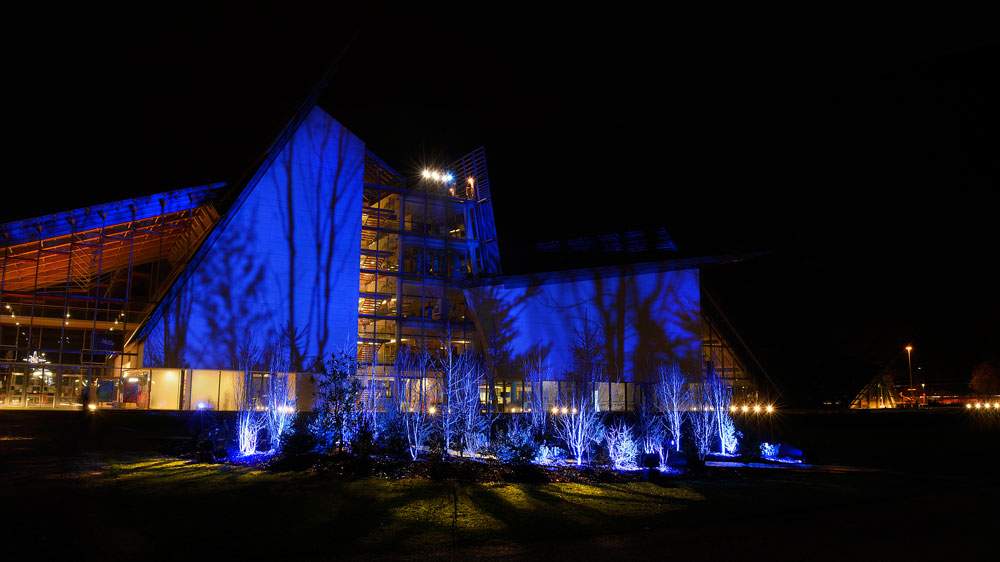An all-you-can-hear miniature forest in the MUSE garden
The garden of the MUSE - Museum of Science in Trento is lit up until May 31, 2021 by alight and sound installation entitled Trees Falling in Love. An installation that aims to remind through lights, plants, voices and environmental sounds the importance of the bond between humanity and the plant world.
The work takes the form of a miniature forest, all to be heard. The voice (and time) of trees is the theme chosen by MUSE for this difficult end of the year, proclaimed by the United Nations as the “International Year of Plant Health.” A theme that focuses on our relationship with the giants of the plant universe and emphasizes the urgency to ecological transition, the need for choices in balance with the diversity, complexity, and otherness of life.
Created as an ideal bridge between the temporary exhibition Tree Time - Art and Science for a New Alliance with Nature, which opened last Oct. 30, and the shots of Forest Frame. The Forest Between Dream and Reality, a photographic exhibition by Maurizio Galimberti coming to Palazzo delle Albere in January, the installation Trees Falling in Love proposes a play of light, sound and shadows, alternating with loud crashing trees and a voice repeating, in fifteen different languages, the phrase “Ladies and gentlemen, we ask you to listen to the trees.” The title of the work recalls the English translation of the felling of a tree, but also the theme of falling in love.
The work is the result of an intense collaboration between various parties: the sound and light apparatus is taken care of by Mariano De Tassis and Carlo Casillo of Miscele d’Aria Factory, with Nicola Fadanelli on viola and violin and Mauro Andreolli on sound optimization; the scientific advice by Costantino Bonomi, head of the Botany section of MUSE; the staging by the Agenzia Provinciale Foreste Demaniali and MUSE Technical Services, with the collaboration of the Forestry Service of the Autonomous Province of Trento and the valuable support of sponsors (Itas Mutua, Zobele Holding SpA, DAO - Conad, Ricola, Montura).
The installation is also an opportunity to highlight the combination of nature and technology aimed at sustainability. The public is invited to reflect on how the energetic use of the plant resource can prove an important contribution to a more sustainable planet.
Trees Falling in Love is dedicated to caring, the meeting of art and nature. It is a symbolic "urban forest," where light and shadow of the relationship trees and humanity, art and nature, dream and reality are evoked.
“An ancestral relationship,” the authors emphasize. “The wood that man obtains from the forest is destined first to serve primary needs, immediately afterwards to more elective and spiritual ones, such as the production of sound, music, communication. The dramatic, primal and somber sound of a tree felled by man can thus, depending on the motivations behind it, be a premise, omen and metaphor for a harmful and invasive use of nature, or the opposite: a necessary and vital antecedent for the creation of beauty, music, harmony. A work that relaxes the mind, a space of joy, of play but also of reflection, of listening, of searching for the moment.”
Music composed for four “woods,” single stringed instruments, envelops the path. The unique and serial piece is composed in “true” quadraphony: the notes merge in the listener’s mind to generate a harmony that goes beyond the sum of the parts. Cyclically and suddenly, the sound of the felling of a large tree overpowers everything to end with the somber sound of a crash, which interrupts the dreamy dimension for a moment, reminding us of the cycles of life, crises, and extinctions. From this thud, however, the harmony of the four instruments emerges again, and the forest of sound sprouts again for the next visitor.
Light becomes identity through the articulation of shapes and volumes, the assortment and diverse nature of surfaces, the contrast between voids and solids, the colors and textures of different leaves, roots and woods. At dusk, natural light slowly gives way to artificial light, beginning its dance consisting of small movements of intensity and slight but constant color changes.
The forest in Trees Falling in Love, albeit in miniature, represents a natural and biodiversity-rich forest, and therefore one that is better able to withstand extreme events, keeping intact or quickly returning to its previous situation. Individuals of different age classes are present: some older patriarchs and younger individuals, a sign of vitality and regrowth, of cyclicity and continuity over time. There is stratification with many niches occupied by different species that have deployed particular strategies to adapt to different light and exposure conditions.
 |
| An all-you-can-hear miniature forest in the MUSE garden |
Warning: the translation into English of the original Italian article was created using automatic tools. We undertake to review all articles, but we do not guarantee the total absence of inaccuracies in the translation due to the program. You can find the original by clicking on the ITA button. If you find any mistake,please contact us.





























